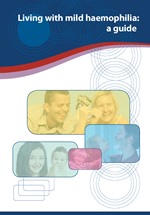 Living with mild haemophilia: a guidE
Living with mild haemophilia: a guidE
A comprehensive guide to living with mild haemophilia, including diagnosis, genetic inheritance and planning a family, treatment and care, special issues for girls and women and information on living well.
Download the full booklet 2.95MB
SECTIONS
Understanding mild haemophiliaThis introduction explains the health condition haemophilia and how people with mild haemophilia are affected. It outlines the different types of inherited haemophilia (haemophilia A and B), how common it is, levels of severity, symptoms and treatment. |
How bleeding starts and stopsA diagram showing the clotting process and how clotting is different in haemophilia – why bleeding continues. |
DiagnosisAlthough people are born with haemophilia, people with mild haemophilia may not be diagnosed until they are older. This section explains how people with mild haemophilia are diagnosed and the role of the Haemophilia Treatment Centre. It includes personal experiences of people with mild haemophilia. |
Family and inheritanceWith a diagram to show how haemophilia is passed down from parent to child, this section walks through the genetics of haemophilia, the link to sex chromosomes and how it is inherited. It also explains spontaneous mutations, where there is no family history. |
Treatment and careWhen you have haemophilia, it is important to be able to identify a bleeding episode (bleed) and to have a treatment plan in place. Your Haemophilia Treatment Centre can help you with this and to put a treatment plan in place. This section covers the precautions you need to take, what to expect with mild haemophilia and how to recognise a bleed. It includes what to do about an injury or bleeding and the treatment options available. It also explains what to tell your other doctors or dentist, immunisation methods and medications to be avoided. |
Living with mild haemophiliaYou may be wondering about how living with mild haemophilia will affect your life. This section begins with some personal experiences, then looks at connecting with others, travel, moving interstate or overseas and sport and other activities. It covers common questions about working, insurance and superannuation, school and childcare and telling friends and new partners. |
Carrying the haemophilia gene – special issues for girls and womenWomen and girls who have the gene alteration causing haemophilia will have a range of issues to deal with over their lifetime. This section is an overview explaining why some females have a bleeding tendency and some do not, managing bleeding symptoms, genetic testic, pregnancy and childbirth. |
Planning a familyThis section outlines the common questions to consider when planning a family if you have mild haemophilia or carry the gene. |
Living well with mild haemophiliaThis section has tips from people with mild haemophilia, parents and Haemophilia Treatment Centre teams on living well. |
More informationHow can you find out more on mild haemophilia or where to contact your local Haemophilia Foundation or Haemophilia Treatment Centre? This section gives some handy contact details, along with references and acknowledgments for those who contributed to the booklet. |
October 2011 edition

 Living with mild haemophilia: a guidE
Living with mild haemophilia: a guidE